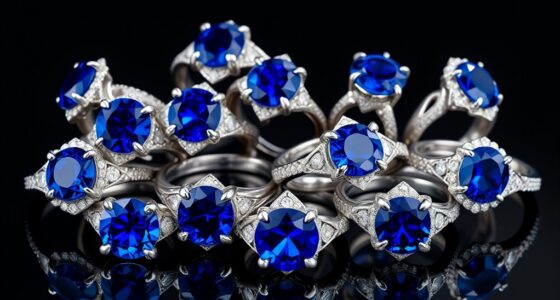Looking for the best flatbed scanner to capture your artwork with stunning detail in 2025? I recommend considering models like the Epson Perfection V850 Pro, Canon CanoScan 9000F MKII, and high-resolution large-format options like VIISAN VF3240. Portability, scan size, color accuracy, and software compatibility are key factors. If you want to get the most out of your art scans, keep exploring these top choices—there’s plenty more to discover.
Key Takeaways
- Look for high optical resolution (4800 dpi or higher) to capture fine textures and details in artwork.
- Prioritize models with excellent color accuracy (48-bit color depth) for true-to-life reproductions.
- Choose scanners supporting large-format or A3 size to accommodate diverse artwork dimensions.
- Consider user-friendly features like auto-scan modes, customizable buttons, and compatible editing software.
- Opt for professional-grade scanners with advanced dust removal and color calibration for archival-quality digitization.
Epson Perfection V19 II Flatbed Scanner
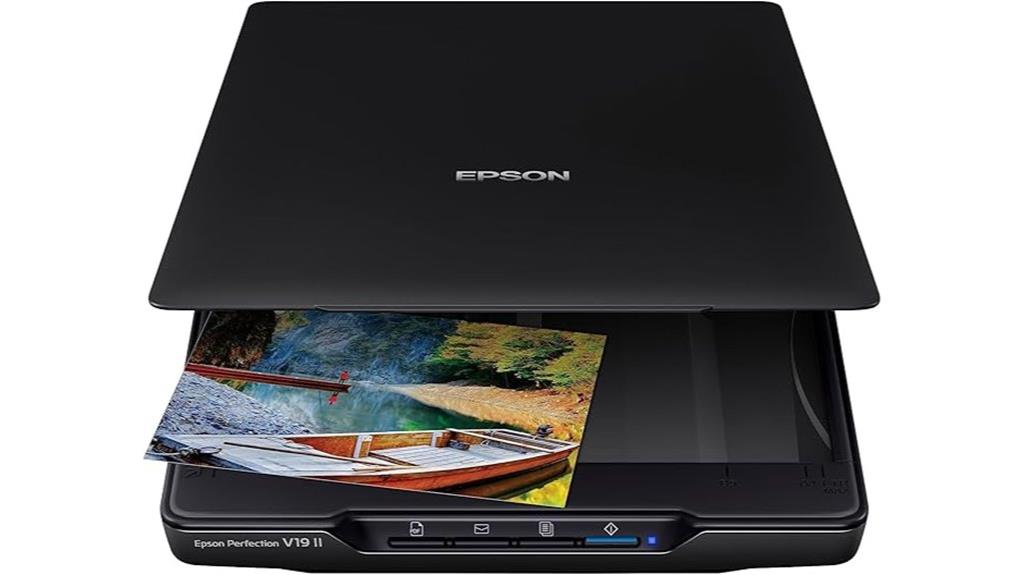
Are you looking for an affordable, easy-to-use scanner that can handle artwork and photos with high detail? The Epson Perfection V19 II is perfect for that. It’s compact, lightweight, and simple to operate, with dimensions of just 14.4 x 9.9 x 1.5 inches and weighing only 3.1 pounds. It offers a stunning 4800 dpi resolution, ensuring your scans capture every detail. Plus, it can quickly scan letter-sized images in around 10 seconds. With its built-in kickstand and removable lid, it handles bulky items like photo albums and books with ease. Overall, it’s a practical choice for artists and hobbyists alike.
Best For: hobbyists, artists, and small office users seeking a compact, high-resolution scanner for photos, artwork, and documents.
Pros:
- High 4800 dpi resolution for detailed scans of photos and artwork
- Compact and lightweight design for portability and easy storage
- User-friendly features like one-touch scanning, OCR, and Easy Photo Fix technology
Cons:
- Limited to letter-sized documents and images; not suitable for large-format scans
- Requires software installation and internet access for full functionality
- Lacks advanced features found in higher-end scanners, such as auto document feeders
Epson Perfection V39 II Flatbed Scanner
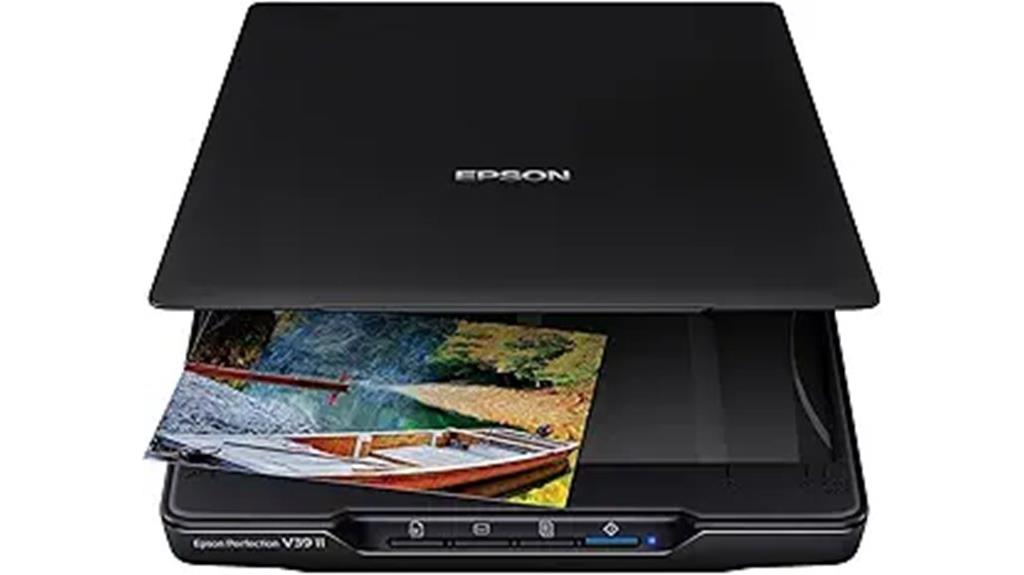
The Epson Perfection V39 II is an excellent choice for artists and hobbyists who need high-resolution scans without sacrificing portability. Its compact size (14.4 x 9.9 x 1.5 inches) and light weight (just 3.1 pounds) make it easy to handle and set up anywhere. With a 4800 dpi optical resolution, it captures fine details in artwork, photos, and documents. Fast scanning speeds—around 10 seconds for letter-sized images at 300 dpi—save time. The included Epson ScanSmart software simplifies saving to USB, cloud, or editing files with OCR. Overall, this scanner offers impressive quality in a sleek, portable design perfect for creative workflows.
Best For: artists, hobbyists, and creative individuals seeking high-resolution scans in a portable, easy-to-use device.
Pros:
- Compact, lightweight design for portability and easy setup
- High 4800 dpi resolution ensures detailed, high-quality scans
- User-friendly Epson ScanSmart software with OCR and cloud integration
Cons:
- Slightly lower customer rating (4.0 stars) indicating some user variability
- Limited to letter-sized scans at a quick speed, which may be less suitable for larger formats
- No built-in fax or advanced editing features found in higher-end scanners
Canon Canoscan Lide 300 Scanner (PDF, AUTOSCAN, COPY, SEND)

If you’re looking for a compact scanner that simplifies digitizing artwork and documents, the Canon Canoscan Lide 300 stands out with its Auto Scan Mode. It quickly detects whether you’re scanning a photo or document, saving you time. With a 2400 x 2400 dpi resolution, it captures fine details for high-quality digital copies. Its four EZ Buttons give quick access to functions like PDF creation or copying, and a USB connection keeps setup simple. Weighing just 3.6 pounds and measuring under 15 inches, it’s portable and space-efficient. Perfect for home or office, it’s a reliable tool for turning your artwork into crisp digital files.
Best For: home users and small offices seeking a compact, easy-to-use scanner for high-quality digitization of documents and photos.
Pros:
- Fast 10-second scanning with high 2400 x 2400 dpi resolution for detailed digital copies
- Compact, portable design weighing only 3.6 pounds and measuring under 15 inches
- User-friendly with four EZ Buttons and Auto Scan Mode for quick, automatic detection and operation
Cons:
- Limited connectivity options beyond USB, which may restrict setup flexibility
- No advanced features like document feeders or duplex scanning for larger volume workflows
- Slightly higher price compared to basic scanners with fewer features
VIISAN 3120 A3 Flatbed Scanner with 1200 DPI

With its impressive 1200 dpi optical resolution and large A3 scanning capacity, the VIISAN 3120 is an excellent choice for artists and designers who need high-quality digital reproductions of their artwork or large-format documents. Its frameless, narrow boundary design simplifies scanning thick items like photo albums and books. Compatible with Windows and MacOS, it offers fast, vivid scans with true-to-life color accuracy. The device supports large formats up to 11×17 inches and features user-friendly buttons for quick operations. Although some software limitations exist, especially at higher resolutions, it remains a reliable option for light to moderate professional use.
Best For: artists, designers, and hobbyists who need high-resolution, large-format scanning for artwork, photos, and documents up to A3 size.
Pros:
- High optical resolution of 1200 dpi ensures detailed, true-to-life scans.
- Large scanning capacity up to 11×17 inches suitable for professional and creative projects.
- User-friendly buttons and quick auto-scan feature simplify operation and improve efficiency.
Cons:
- Software limitations at higher resolutions can affect scan quality and editing capabilities.
- Some users report slow scanning speeds and occasional software glitches.
- Proprietary software may be outdated or less compatible with third-party applications.
VIISAN VF3240 Large Format Flatbed Scanner

For artists, designers, and educators who need to digitize large artwork or detailed documents, the VIISAN VF3240 offers an impressive combination of size and resolution. It’s an A3 large-format flatbed scanner that handles photos, paintings, books, and CAD drawings up to 12″ x 17″ with ease. Its 2400 x 2400 dpi resolution and 48-bit color depth guarantee sharp, vibrant images. The frameless, narrow boundary design makes scanning more efficient, while the auto-scan feature speeds up workflows. Compatible with Windows and MacOS, it’s perfect for high-quality digitization, though it’s limited to flat objects and doesn’t support 3D items.
Best For: artists, designers, and educators who need to digitize large artwork, detailed documents, or CAD drawings with high resolution and color accuracy.
Pros:
- High maximum resolution of 2400 x 2400 dpi with 48-bit color depth for sharp, vibrant images
- Frameless, narrow boundary design enhances scanning efficiency of large-format documents
- Fast scanning speed of approximately 4 seconds for A3 size at 200 dpi in color
Cons:
- Limited to flat objects; cannot scan 3D items like clothes or CDs
- WIA driver restrictions limit scanning resolution to 600 dpi on Windows, not utilizing full potential
- Cannot scan textured or non-flat items, reducing versatility for certain projects
Plustek OpticSlim 1680 Flatbed Scanner
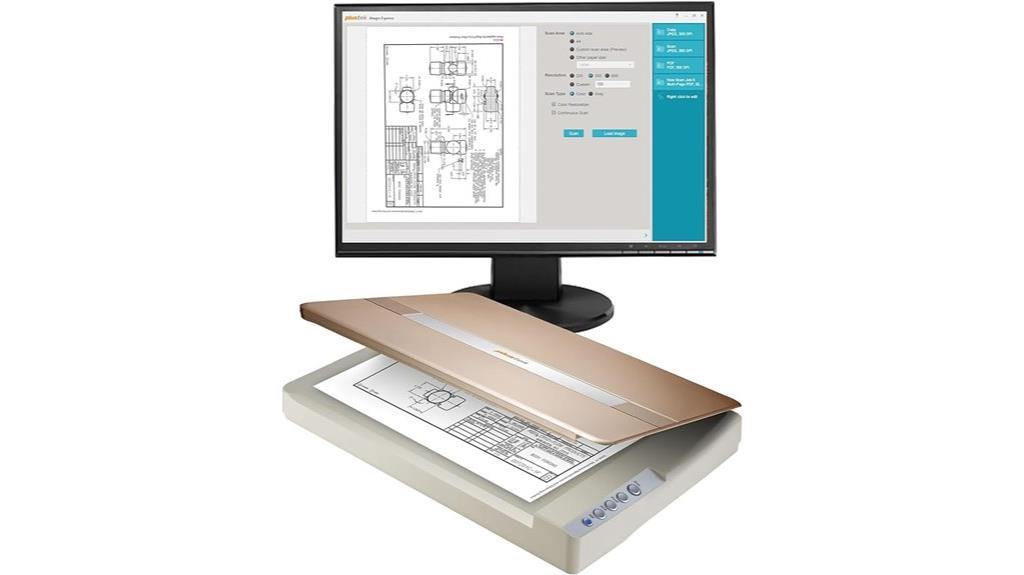
The Plustek OpticSlim 1680 stands out as an ideal choice for artists and designers who need fast, high-quality scans of large artwork. It can scan tabloid-sized documents in just 3 seconds at 300dpi grayscale or 5 seconds in color, making it highly efficient. With one-key operation and four customizable buttons, it simplifies workflow, letting you quickly set destinations and file types. Its dual-view advanced settings allow for instant image adjustments, ensuring each scan is perfect. Compatible with Windows and Mac, it offers broad software support. Compact and lightweight, it’s easy to integrate into any studio setup while providing professional-level results.
Best For: artists and designers needing fast, high-quality scans of large artwork and tabloid-sized documents.
Pros:
- Rapid scanning capability, capturing tabloid-sized documents in just 3-5 seconds at 300dpi.
- User-friendly with one-key operation and customizable buttons for streamlined workflow.
- Broad compatibility with Windows and Mac, supported by TWAIN and ICA standards.
Cons:
- Customer rating of 3.8 out of 5 suggests mixed user experiences.
- Limited to flatbed scanning, which may not suit users needing document feeding features.
- Slightly bulky dimensions could impact portability for on-the-go use.
Plustek OS1180 Flat Scanner for A3 Documents

If you’re looking for a reliable flat scanner that handles large artwork or documents effortlessly, the Plustek OS1180 is an excellent choice. It supports A3-sized scans up to 11.7 x 17 inches, perfect for big projects. With a fast 9-second scan time and LED illumination, it offers quick, energy-efficient performance without warm-up delays. The one-touch preset button makes scanning simple, reducing effort and boosting productivity. Its software bundle includes ABBYY for accurate OCR and DocAction for easy file sharing. Designed for professional and educational use, the OS1180 delivers high-quality, large-format digital captures with ease and efficiency.
Best For: professionals and educators needing quick, high-quality large-format scans of artwork, documents, or projects in A3 size.
Pros:
- Fast 9-second scan time with LED illumination for energy-efficient, warm-up free operation
- User-friendly one-touch preset button simplifies scanning tasks
- Supports high-quality color and grayscale modes with included OCR and file sharing software
Cons:
- Limited to A3-sized documents; not suitable for smaller or larger formats
- May require additional software configuration for optimal OCR accuracy
- Bulkier design may take up more space in smaller work areas
Visioneer 7800 Flatbed Scanner for PC with Tag That Photo Software
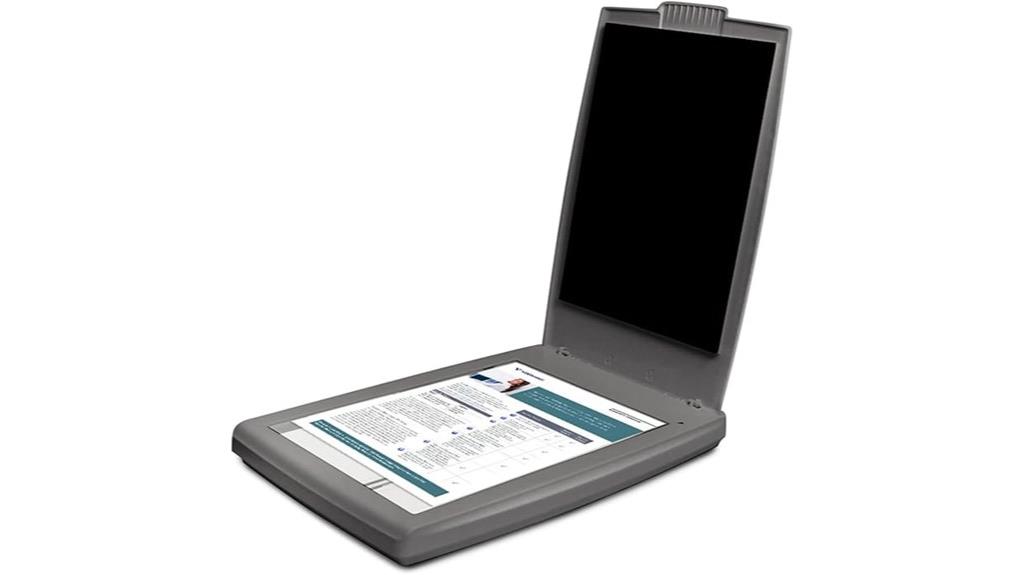
Designed with artists and photographers in mind, the Visioneer 7800 flatbed scanner delivers high-resolution color and black-and-white scans with true 1200 dpi clarity. Its compact, lightweight design makes it perfect for home studios or offices, weighing less than 4 pounds and fitting easily on a desk. Equipped with TWAIN driver technology, it produces sharp images with auto color detection and versatile media handling. The included Tag That Photo software, with a one-year subscription, offers facial recognition, tagging, and easy organization across local, cloud, or server libraries. Users appreciate its simplicity, though some encounter driver or software glitches. Overall, it’s a reliable choice for detailed artwork digitization.
Best For: artists, photographers, and home users seeking high-resolution scanning and organized photo management for their creative projects.
Pros:
- High true 1200 dpi optical resolution for detailed scans of photos and artwork
- Compact, lightweight design suitable for home or studio use
- Includes Tag That Photo software for facial recognition and easy organization
Cons:
- Occasional driver or software glitches can disrupt workflow
- Cropping features are limited, which may affect precise editing
- Some users report difficulty in locating drivers or initial setup issues
Xerox XD-COMBO Duplex Document Scanner for PC and Mac

For artists and designers who need high-quality scans of artwork, the Xerox XD-COMBO Duplex Document Scanner offers a practical solution with its ability to handle various media types, including thick documents, photos, and ID cards. Its compact design and 35-page ADF make it suitable for both home and office use. It scans in color, grayscale, and black-and-white at speeds up to 25 ppm, delivering crisp images at 300 dpi. The duplex feature allows quick two-sided scanning in a single pass, boosting efficiency. While the software interface feels outdated, the scanner’s versatility and reliable performance make it a valuable tool for digitizing artwork and documents with precision.
Best For: artists, designers, and professionals who need reliable, high-quality scanning of artwork, photos, and various media types in a compact and versatile device.
Pros:
- Handles a wide range of media including thick documents, photos, and ID cards, making it highly versatile.
- Duplex scanning feature speeds up two-sided document digitization in a single pass, improving workflow efficiency.
- Compact and lightweight design ideal for home offices, studios, or on-the-go scanning needs.
Cons:
- Outdated software interface can be difficult to navigate and may hinder ease of use.
- Limited driver support and support resources for newer operating systems like Windows 10 and Windows 11.
- Replacement parts, such as power supplies, are difficult to obtain, which could impact long-term usability.
Epson Perfection V500 Flatbed Scanner

The Epson Perfection V500 Photo Flatbed Scanner stands out with its impressive 6400 dpi optical resolution, making it an excellent choice for artists seeking high-quality scans of artwork and detailed images. It features a hardware resolution of 6400 x 9600 dpi and interpolates up to 12,800 x 12,800 dpi, capturing fine details with clarity. Equipped with a CCD sensor and 48-bit color depth, it handles photos and documents up to 8.5 x 11.7 inches. While praised for its ease of use and build quality, some users face driver compatibility issues with modern Windows systems. Despite being discontinued, it remains a solid option for high-resolution scanning at a good value.
Best For: artists and photographers seeking high-resolution scans of artwork, photos, and detailed images for archival or reproduction purposes.
Pros:
- High 6400 dpi optical resolution ensures detailed and sharp scans of artwork and photos
- Easy to set up and use with good build quality, suitable for home or small office use
- Supports a wide color depth of 48-bit, capturing rich and accurate colors
Cons:
- Driver compatibility issues with modern Windows operating systems like Windows 10 and Windows 11
- Discontinued by the manufacturer, leading to potential difficulties in obtaining updates or support
- Some users experience crashes or problems with the preview window due to outdated drivers
Epson Expression 13000XL Archival Photo and Graphics Flatbed Scanner
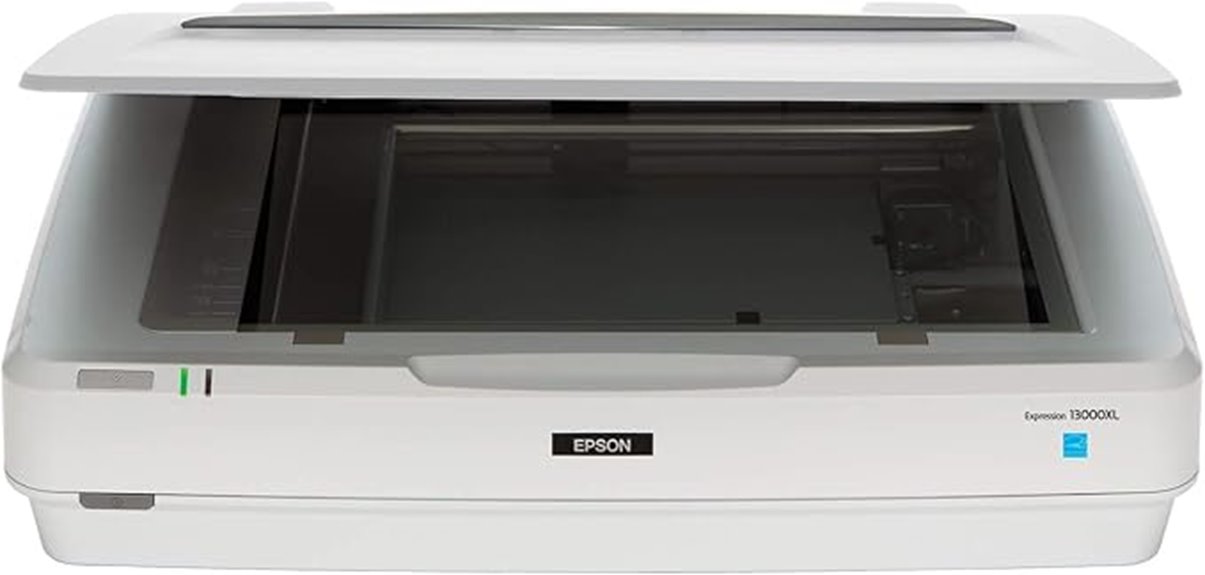
If you’re serious about archiving artwork or handling large-format projects, the Epson Expression 13000XL stands out with its impressive 12.2 x 17.2-inch scanning bed, making it ideal for professional photo archiving and graphic arts. It offers a high resolution of 2400 x 4800 dpi and features Epson Micro Step Drive technology for sharp images. With 48-bit color depth and advanced color restoration, it produces vibrant, true-to-original results. The scanner supports batch scanning for efficiency and includes dust removal technology. Its compatibility with professional software like SilverFast Ai ensures precise calibration, making it a top choice for demanding creative and archival tasks.
Best For: professionals and serious hobbyists who need large-format scanning capabilities for high-quality photo archiving, graphic arts, and demanding creative projects.
Pros:
- High-resolution scanning up to 2400 x 4800 dpi ensures detailed and sharp images.
- Large scanning bed (12.2 x 17.2 inches) accommodates big artwork and documents.
- Advanced color restoration and dust removal technology enhance image quality and reduce post-processing time.
Cons:
- Relatively heavy and bulky design may require a dedicated space for setup.
- Price point may be high for casual users or those with infrequent scanning needs.
- Compatibility relies on software support; some users may experience setup or driver issues.
Epson WorkForce ES-50 Portable Sheet-Fed Document Scanner for PC and Mac

When I need to digitize artwork quickly and on the go, the Epson WorkForce ES-50 Portable Sheet-Fed Document Scanner stands out as an ideal choice. It’s the lightest and fastest mobile scanner in its class, scanning a single page in just 5.5 seconds. It handles documents up to 8.5 x 72 inches, including ID cards and receipts, making it versatile for various artworks. Powered via USB, it requires no batteries or external power. Its compatibility with Windows and Mac, along with software like Epson ScanSmart and Nuance OCR, ensures efficient workflow. At just 9.4 ounces, it’s perfect for artists needing portability without sacrificing speed or quality.
Best For: artists and professionals who need a portable, quick, and reliable scanner for digitizing artwork, ID cards, and receipts on the go.
Pros:
- Lightweight and highly portable at just 9.4 ounces, ideal for mobile use
- Fast scanning speed of 5.5 seconds per page, saving time during busy workflows
- Compatible with Windows and Mac, with software options for easy editing and cloud integration
Cons:
- Limited to scanning single pages; not suitable for high-volume batch scanning
- Requires USB power, which may limit flexibility in certain environments without a computer nearby
- May have compatibility issues with older or less common operating systems not listed in system requirements
HP ScanJet Pro 2500 f1 Flatbed Scanner (L2747A)
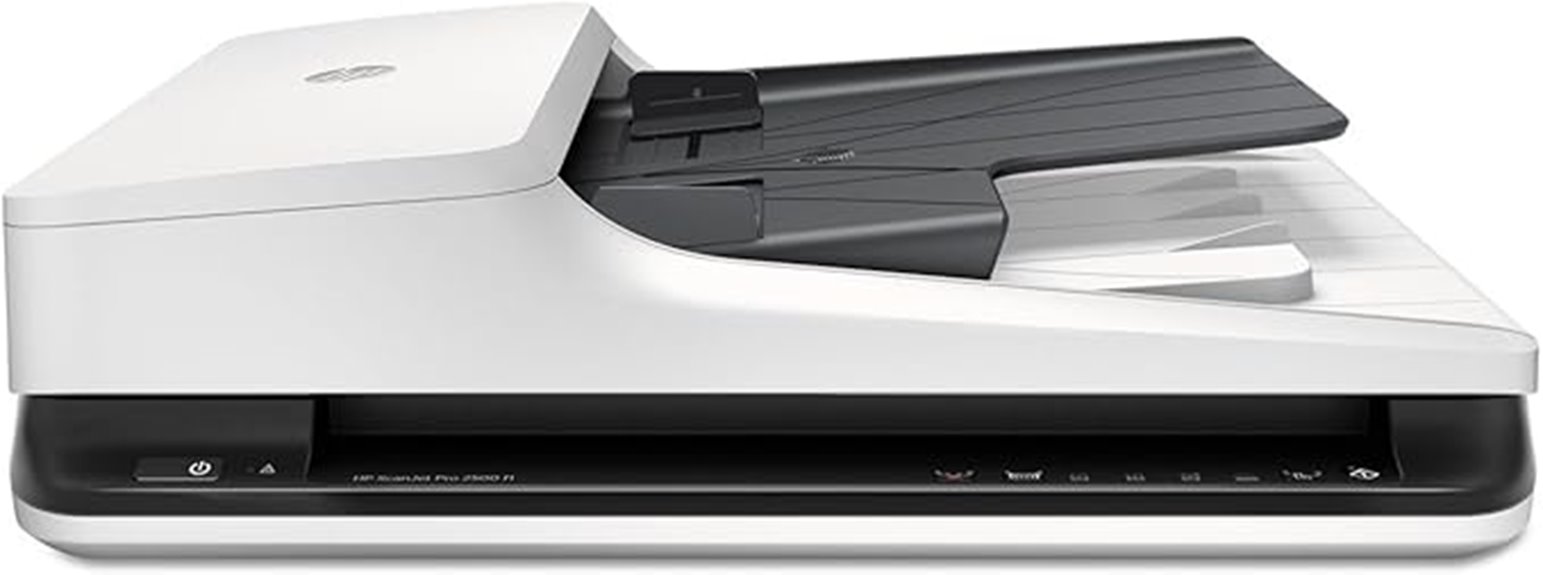
Artists and designers seeking high-quality scans of artwork will find the HP ScanJet Pro 2500 f1 particularly useful, thanks to its ability to produce sharp, true-to-life images at up to 1200 dpi. This scanner is fast, capable of scanning 40 images per minute with two-sided scanning, and features a 50-page automatic document feeder for efficiency. It can handle large pages up to 8.5 x 122 inches through the ADF and manages bulky media on the flatbed. With instant-on technology and all-encompassing editing software, it streamlines workflows while delivering professional-quality results, making it ideal for high-volume, detail-oriented work.
Best For: artists, designers, and professionals requiring high-resolution, fast, and versatile scanning of artwork, graphics, and bulky media in high-volume environments.
Pros:
- Produces sharp, true-to-life scans at up to 1200 dpi for detailed artwork and graphic reproductions.
- Fast scanning capability of up to 40 images per minute with two-sided scanning, increasing productivity.
- Supports large page sizes up to 8.5 x 122 inches and handles bulky media on the flatbed, ideal for diverse media types.
Cons:
- Relatively compact size may limit handling of extremely large or oversized media beyond 8.5 inches width.
- Price point may be higher compared to basic scanners, reflecting its professional features.
- Customer ratings are generally positive but suggest some users experience occasional software or hardware compatibility issues.
Canon CanoScan 9000F MKII Scanner

The Canon CanoScan 9000F MKII Scanner stands out as an excellent choice for anyone looking to digitize artwork, photos, or films with ease. It’s compatible with Windows 8, Windows RT, Windows 7, Vista, XP, and Mac OS X v10.6.8 to 10.7, making it versatile for most users. This refurbished model is inspected and tested to look and function like new, backed by Amazon’s Renewed Guarantee. Its features include My Image Garden software for simple organization, FAER Level 3 for automatic dust and scratch removal, and energy-efficient LEDs. With quick operation, it’s perfect for artists wanting high-quality scans without hassle.
Best For: artists, photographers, and hobbyists seeking a reliable, high-quality scanner for digitizing artwork, photos, and films with ease.
Pros:
- Compatible with a wide range of operating systems including Windows and Mac OS X.
- Features FAER Level 3 for automatic dust and scratch removal, ensuring high-quality scans.
- Includes user-friendly My Image Garden software for easy organization and management of scanned images.
Cons:
- Heavier and larger than some compact scanners, which may require dedicated space.
- Being a refurbished product, it may have a limited warranty compared to new models.
- Limited to Mac OS X v10.6.8 to 10.7, which may be outdated for some users with newer Mac OS versions.
Epson Perfection V850 Pro scanner

For anyone seeking professional-grade scans of artwork, the Epson Perfection V850 Pro stands out with its 6400 dpi resolution, delivering ultra-high-definition images with exceptional detail. Its remarkable tonal range, thanks to a 4.0 Dmax, ensures smooth gradations and fine shadow details. The scanner’s exclusive dual lens system intelligently selects between two lenses to optimize results, capturing every nuance of your artwork. Compatibility is broad, supporting Windows 7 through 8.1 and various Mac OS X versions. Whether you’re digitizing paintings, sketches, or prints, the V850 Pro provides the precision and quality necessary for professional archiving and reproduction.
Best For: professional artists, photographers, and archivists seeking high-resolution, detailed scans of artwork, prints, and delicate materials.
Pros:
- Ultra-high 6400 dpi resolution captures fine details with exceptional clarity
- Remarkable tonal range with 4.0 Dmax ensures smooth gradations and shadow detail
- Dual lens system optimizes scan quality for different types of artwork and materials
Cons:
- Relatively high cost may be a barrier for casual users
- Large scanner size requires ample workspace
- May require a powerful computer and sufficient storage for high-resolution files
Factors to Consider When Choosing a Flatbed Scanner for Artwork

When selecting a flatbed scanner for artwork, I focus on key factors like resolution and color accuracy to make sure my scans capture every detail and true hue. I also consider scan size and format to match my project needs, along with software compatibility for smooth editing. Finally, I look for ease of use to make the scanning process efficient and hassle-free.
Resolution and Detail
Ever wondered how to guarantee your artwork is captured with all its fine details? The key is in the resolution. A scanner with an optical resolution of 4800 dpi or higher ensures you can capture intricate lines and subtle textures without losing clarity. Higher optical resolution, not just interpolated numbers, directly reflects the true level of detail the scanner can record, which is vital for accurate reproductions. A 48-bit color depth broadens the color spectrum, allowing for richer, more vibrant images that faithfully represent your artwork. Scanning at high resolutions also means you can enlarge images later without sacrificing sharpness or detail, perfect for prints or digital displays. Consistency in image clarity at these resolutions guarantees your artwork’s fine nuances are preserved precisely.
Color Accuracy
Achieving true-to-life colors in your artwork scans requires careful attention to several key factors. First, a high color depth, like 48-bit, ensures a broader range of colors and more accurate reproduction. Scanners with features such as Epson’s Easy Photo Fix can restore faded or damaged artwork, keeping colors vibrant. LED lighting provides consistent, flicker-free illumination, which is vital for capturing accurate colors across different media types. Additionally, calibration tools and software, including ICC profiles and color management systems, help maintain color consistency and realism. Finally, optical resolution impacts color fidelity by capturing finer details and ensuring faithful color reproduction at high resolutions. Considering these factors will help you select a scanner capable of delivering precise, true-to-life colors for your artwork.
Scan Size and Format
Selecting the right scanner size and format is essential to capturing your artwork accurately. You need to verify the scanner supports the maximum dimensions of your work, whether it’s A3 or larger, to avoid cropping or resampling. Check the optical resolution—2400 dpi or higher is recommended for detailed, high-quality scans, especially if you plan to enlarge your images. If you work with oversized or panoramic pieces, confirm the scanner’s maximum scan size to prevent limitations. Also, consider whether it can handle various media types, like textured surfaces or thick pages, within its size limits. Finally, review the software features for stitching or multi-page scanning if your artwork exceeds standard sizes. Getting these factors right ensures your digital reproductions are precise and complete.
Software Compatibility
Choosing a flatbed scanner for artwork depends heavily on its software compatibility, ensuring it works smoothly with your existing tools and workflow. I look for scanners that support TWAIN and WIA drivers, so I can easily integrate them with my preferred editing software. It’s essential that the scanner’s software includes features like color correction and dust removal, which save me time and improve image quality. Regular driver updates are vital to maintain compatibility with the latest operating systems like Windows 11 and macOS. I also prefer scanners with user-friendly software bundles that simplify scanning, editing, and file management. Additionally, seamless integration with cloud storage and digital asset management tools allows me to access and edit my artwork files effortlessly, keeping my workflow efficient and organized.
Ease of Use
When evaluating flatbed scanners for artwork, ease of use is a key factor that can make or break your workflow. A user-friendly scanner should have a simple interface, ideally with one-touch buttons or presets for common tasks, so you don’t waste time navigating complex menus. Clear instructions and intuitive software help you operate the scanner efficiently, reducing the need for extensive training. Features like auto-detect modes, automatic document size detection, and straightforward adjustments streamline the process, saving you effort and minimizing errors. Compact designs with minimal setup requirements enable quick deployment, preventing frustration. Compatibility with popular operating systems and easy-to-use software ensure smooth integration, making the scanning process seamless. Ultimately, ease of use helps you focus on your art rather than technical hurdles.
Price and Value
Price and value are critical considerations when picking a flatbed scanner for artwork, as a higher price often means better resolution, color accuracy, and build quality that can truly enhance your work. Investing in a scanner with 4800 dpi or higher and 48-bit color depth can notably improve image quality, making detailed reproductions more accurate. However, budget scanners may lack essential features like high DPI or advanced color management, reducing their usefulness for professional art. The true value lies in balancing cost with features such as compatibility, software support, and ease of use. Also, consider long-term costs like warranties, updates, and customer support. Ultimately, choosing a scanner that offers the right combination of features and durability ensures you get the best value for your investment.
Connectivity Options
Connectivity options play a crucial role in ensuring your flatbed scanner integrates smoothly into your workflow and offers the flexibility you need. I recommend looking for scanners with USB, Ethernet, or Wi-Fi, so you can set up your workspace with ease and scan remotely when needed. Modern standards like USB 3.0 or USB-C are essential for faster data transfer and compatibility with newer devices. Wireless connectivity is a game-changer, allowing you to scan directly to networked devices or cloud services without cables, which saves time. Also, check if the scanner supports multiple ports or can connect to several devices simultaneously—this is especially useful in shared or professional environments. Ensuring these options are available helps you stay efficient and adaptable in your creative process.
Frequently Asked Questions
How Do Flatbed Scanners Differ for Artwork Compared to Standard Document Scanning?
Flatbed scanners designed for artwork differ from standard document scanners mainly in resolution, color accuracy, and detail capture. I find that art scanners offer higher DPI settings, allowing me to scan fine lines and textures precisely. They also provide better color depth, which is essential for true-to-life reproductions. Unlike document scanners, these are built to handle delicate and complex artwork, ensuring I get a detailed, vibrant digital copy every time.
What Features Improve Color Accuracy for Artwork Digitization?
Think of your scanner as a painter’s palette—color accuracy is key. To improve it, I look for features like advanced color management, high bit depth (at least 48-bit), and ICC profile support. These ensure vibrant, true-to-life reproductions. Additionally, calibration tools help maintain consistency. When you invest in these features, your digital artwork will capture the richness and nuance of your original creations, just like a master’s touch.
Can Flatbed Scanners Handle Textured, Thick, or Fragile Artwork?
Yes, flatbed scanners can handle textured, thick, or fragile artwork, but it depends on the model. I recommend looking for one with adjustable height or a flexible lid, so you don’t press too hard on delicate pieces. Using a glass sheet or a non-reflective cover can help safeguard fragile artwork while capturing detailed textures. Always test on a small section first to ensure your work stays safe.
How Important Is Resolution When Scanning Detailed Artwork?
Think of resolution as the lens to your artistic soul—crucial for capturing every fine detail. I’d say resolution is extremely important when scanning detailed artwork because it determines how crisp and true-to-life your digital image will be. Higher resolution means more pixels, which means more clarity, especially for intricate lines or textures. Skimp on it, and your artwork risks losing its depth, making your digital version less vibrant and true.
Do Flatbed Scanners Support Different File Formats Suitable for Artwork Archives?
Yes, flatbed scanners support various file formats perfect for artwork archives. I usually save my scans in TIFF for high quality, especially if I plan to edit later. JPEG works well for sharing online, while PNG is great for lossless compression. Most scanners let you choose the format during or after scanning, giving you flexibility to preserve your artwork in the best possible way.
Conclusion
So, there you have it—your trusty sidekicks in the quest for perfect artwork scans. Remember, choosing the right scanner isn’t just about pixels; it’s about pretending you’re a professional while secretly hoping your artwork doesn’t look like it was run over by a truck. Whether you go budget or pro, just don’t forget to lie convincingly about how much you know. Happy scanning, artist extraordinaire!


